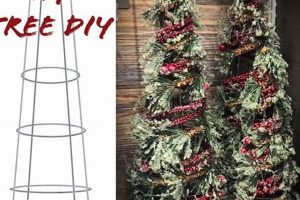Creating decorative strands for adorning a holiday centerpiece offers an opportunity for personalized expression and festive embellishment. These handcrafted decorations, intended to be draped across the branches of an evergreen during the yuletide season, range from simple popcorn and cranberry chains to elaborate arrangements of fabric, beads, and natural materials.
The practice of crafting individualized embellishments fosters creativity and resourcefulness, potentially reducing reliance on mass-produced items. Historically, homemade decorations reflected available resources and cultural traditions, adding a unique and personal touch to seasonal celebrations. These adornments contribute significantly to the aesthetic appeal and sentimental value of the holiday experience.
Subsequent sections will explore various materials suitable for crafting these decorations, techniques for assembling them, and considerations for ensuring their durability and aesthetic cohesion within the overall holiday theme. This exploration will provide a foundation for individuals to embark on their own personalized decorative projects.
Essential Considerations for Handcrafting Holiday Tree Strands
The successful creation of bespoke holiday tree strands necessitates careful planning and execution. The following guidelines offer insights into material selection, construction techniques, and safety precautions.
Tip 1: Material Selection is Paramount: Prioritize lightweight and durable materials. Heavy embellishments can strain tree branches. Consider felt, paper, or lightweight beads for optimal results.
Tip 2: Establish a Cohesive Theme: Determine a consistent color palette and design aesthetic before commencing. This ensures a harmonious visual integration with the overall holiday decor.
Tip 3: Employ Secure Attachment Methods: Utilize sturdy thread, wire, or adhesive to affix components. Weak connections may result in disintegration and necessitate repairs.
Tip 4: Incorporate Natural Elements: Introduce natural elements such as dried citrus slices, pinecones, or cinnamon sticks. These additions enhance visual appeal and impart a seasonal fragrance.
Tip 5: Prioritize Fire Safety: If incorporating lights, ensure compatibility with the chosen materials. Avoid flammable elements near heat sources to mitigate fire hazards.
Tip 6: Plan for Storage: Design the decorations with ease of disassembly and storage in mind. This ensures the preservation of the strands for subsequent seasons.
Tip 7: Measure Before Beginning: Accurately measure the tree’s circumference to determine the necessary strand length. This prevents material waste and ensures adequate coverage.
Adhering to these guidelines will contribute to the creation of visually appealing, durable, and safe decorations. Thoughtful planning and execution are crucial for a successful outcome.
The subsequent section will address common challenges encountered during the crafting process and provide troubleshooting solutions. This further enhances the likelihood of a positive crafting experience.
1. Material Weight
Material weight constitutes a critical factor in the successful execution of handcrafted decorations for festive trees. The cumulative weight of the chosen elements directly impacts the structural integrity of the tree branches. Excessive weight can cause branches to droop, potentially damaging the tree and detracting from its visual appeal. Conversely, insufficient weight may result in a flimsy appearance, failing to create the desired visual impact. The appropriate selection of lightweight materials is therefore paramount.
Examples of lightweight material choices include felt, paper, lightweight plastic beads, and dried flowers. These materials offer aesthetic versatility without imposing undue stress on the tree. Consider a scenario where heavy glass beads are used extensively; the resulting weight could lead to branch sagging and potential breakage. Conversely, utilizing paper cutouts offers a visually appealing alternative with negligible weight impact. The practical significance of understanding material weight lies in ensuring both the longevity of the decoration and the structural stability of the tree itself.
In summary, the weight of materials selected for handcrafted decorations is a fundamental consideration. Careful selection ensures both visual appeal and the preservation of the tree’s structure. Neglecting this aspect can lead to aesthetic compromises and potential damage. Proper material weight contributes significantly to the overall success and sustainability of the holiday display.
2. Color Harmony
Color harmony plays a pivotal role in the aesthetic success of any handcrafted decoration intended for holiday trees. The selection and arrangement of colors directly influence the visual impact and overall cohesiveness of the display. A lack of chromatic coordination can result in a disjointed and visually jarring presentation, detracting from the intended festive atmosphere. Conversely, a well-considered color scheme enhances the tree’s beauty, creating a sense of balance and visual appeal. For example, a decoration incorporating clashing colors like bright orange and neon green may appear visually chaotic, whereas a decoration employing analogous colors such as shades of blue and green creates a serene and harmonious effect. The deliberate application of color theory principles is essential for achieving a pleasing visual outcome.
The practical application of color harmony extends beyond mere aesthetics. A carefully chosen color palette can evoke specific emotions and reinforce the desired holiday theme. Traditional color combinations, such as red and green, evoke a sense of warmth and nostalgia. Modern palettes, such as silver and gold, project an air of elegance and sophistication. The choice of colors, therefore, should align with the overall decorative theme and the intended emotional response. Furthermore, color harmony considerations can influence material selection. The availability of materials in specific colors may dictate design choices, requiring a flexible approach to the crafting process. Coordinating the colors of different components beads, ribbons, fabrics necessitates careful planning and attention to detail.
In conclusion, the integration of color harmony principles is indispensable for creating visually appealing and cohesive handcrafted decorations. Disregarding chromatic considerations can lead to aesthetically displeasing results. A deliberate and thoughtful approach to color selection, guided by established color theory principles, significantly enhances the overall impact and visual harmony of the holiday display. The mastery of color harmony contributes to the transformation of a simple tree into a striking centerpiece of holiday celebration.
3. Attachment Security
Attachment security is a critical determinant of the longevity and visual appeal of handcrafted adornments. In the context of a holiday evergreen display, compromised attachment integrity can result in components detaching from the main strand, leading to aesthetic degradation and potential hazards. The absence of secure affixation mechanisms necessitates frequent repairs and diminishes the overall value of the creation. Consider a decoration where ornaments are connected to the main thread using inadequate adhesive; the likelihood of these ornaments separating is high, particularly under the weight of the embellishment itself or with environmental fluctuations in temperature and humidity. This instability undermines the intended visual effect and contributes to a perception of inferior craftsmanship.
The practical implications of attachment security extend beyond mere aesthetics. Detached components pose a potential tripping hazard, especially in areas with high foot traffic. Moreover, the materials used in construction, such as small beads or wires, can be dangerous if ingested by children or pets. Therefore, robust attachment methods are not solely about visual perfection but also about ensuring safety within the environment. Employing techniques such as double-knotting, utilizing strong adhesives designed for the specific materials used, and reinforcing connections with wire or thread can significantly enhance the durability and safety of the final product. The strategic placement of attachment points is also important. Even distribution of weight and stress prevents localized weakening of the structure.
In summary, attachment security is paramount in the creation of durable and safe decorations. Its influence extends beyond aesthetics, encompassing safety and longevity considerations. Neglecting this aspect compromises the visual integrity and creates potential hazards. Implementing robust attachment strategies, from material selection to construction techniques, is essential for a successful and enduring creation, ultimately contributing to a safer and more visually appealing holiday display. The investment in secure attachment methods translates into a worthwhile endeavor, ensuring both lasting beauty and peace of mind.
4. Fire Resistance
Fire resistance is a paramount safety consideration in the creation of handcrafted decorations, particularly those intended for use on coniferous evergreens during seasonal celebrations. The proximity of these decorations to potential ignition sources necessitates careful material selection and construction techniques to mitigate fire hazards.
- Material Flammability
The inherent flammability of constituent materials directly influences the fire resistance of the finished product. Highly flammable materials such as untreated paper, certain fabrics, and dried plant matter pose a significant fire risk. Conversely, materials with inherent fire-resistant properties, such as inherently flame-retardant fabrics or properly treated wood, contribute to a safer outcome. For example, decorations constructed primarily from dried pinecones and ribbon pose a greater fire hazard than those composed of glass beads and metal wire.
- Proximity to Ignition Sources
The proximity of decorative strands to potential ignition sources, such as incandescent light bulbs or open flames from candles, dictates the level of fire resistance required. Decorations placed in close proximity to heat sources necessitate the use of inherently fire-resistant materials. For instance, if incandescent lights are utilized on the tree, decorations in direct contact with the bulbs must be composed of non-combustible or flame-retardant materials to prevent ignition. The placement and type of lighting are crucial factors in assessing and mitigating fire risks.
- Flame Retardant Treatments
The application of flame-retardant treatments to otherwise flammable materials can enhance fire resistance. These treatments, which may involve the application of chemical coatings or impregnation with fire-retardant substances, reduce the ignitability and flame spread rate of the treated materials. However, the effectiveness and durability of flame-retardant treatments vary, and periodic reapplication may be necessary. For example, paper decorations can be treated with a commercially available flame-retardant spray to improve their resistance to ignition.
- Decoration Density and Ventilation
The density of materials and the availability of adequate ventilation around the decorations significantly influences fire risk. Densely packed, poorly ventilated decorations create conditions conducive to rapid fire spread. Open designs with ample airflow allow for heat dissipation and reduce the likelihood of sustained combustion. For example, a tightly packed fabric decoration poses a greater fire risk than a sparsely constructed strand with ample ventilation between components.
In conclusion, prioritizing fire resistance in the creation of handcrafted seasonal decorations is essential for minimizing fire hazards and ensuring safety. Careful attention to material selection, ignition source proximity, flame-retardant treatments, and decoration density is crucial for mitigating fire risks associated with these decorative elements. Implementing these safety measures contributes to a safer and more enjoyable holiday experience.
5. Storage Feasibility
The enduring value of handcrafted holiday tree strands is directly correlated with their storage feasibility. Decorations designed without consideration for subsequent storage often suffer damage or degradation, diminishing their aesthetic appeal and necessitating frequent replacement. The inherent fragility of many constituent materials used in these creations, such as delicate paper ornaments or intricate beadwork, renders them particularly vulnerable to damage during the off-season. Therefore, the incorporation of storage considerations into the design and construction phases is crucial for maximizing the lifespan and usability of these seasonal embellishments. For example, a strand composed of densely packed, irregularly shaped elements may prove difficult to store compactly and without damage, whereas a strand designed with flat, modular components can be disassembled and stored efficiently in a small container.
The practical implications of prioritizing storage feasibility extend beyond simple convenience. Efficient storage minimizes space requirements, a significant consideration for individuals with limited storage capacity. Furthermore, proper storage protects the strands from environmental factors, such as humidity and dust, which can accelerate material degradation. Acid-free tissue paper, for example, can be used to wrap individual components, preventing discoloration and protecting delicate surfaces from scratches. A well-designed storage solution also facilitates organization, making it easier to retrieve and reassemble the strands in subsequent years. Durable containers, labeled clearly with contents and handling instructions, prevent accidental damage and ensure that all components are readily accessible when needed.
In conclusion, the storage feasibility of handcrafted holiday tree strands is an integral aspect of their overall value and sustainability. Decorations designed with storage in mind exhibit enhanced durability, minimize space requirements, and protect against environmental damage. Neglecting this critical consideration leads to premature degradation, increased replacement costs, and diminished enjoyment of the holiday tradition. Therefore, incorporating storage considerations into the design and construction processes is an essential investment, ensuring the longevity and enduring appeal of these cherished seasonal decorations.
6. Length Accuracy
Length accuracy is a fundamental determinant of the aesthetic and functional success of any handcrafted holiday tree strand. The accurate calculation and execution of the decoration’s length directly impacts its visual harmony and its ability to effectively adorn the intended centerpiece. Insufficient length results in incomplete coverage, undermining the intended visual effect. Excessive length, conversely, creates unsightly overlaps and potential entanglement. A decoration intended to spiral uniformly around a tree, but fabricated with inaccurate length calculations, may exhibit gaps in some areas and dense bunching in others, thereby disrupting the overall visual equilibrium. Therefore, the precision in determining the strand’s length is not merely a detail but a foundational element of the crafting process.
The practical significance of length accuracy manifests throughout the creation process. Prior to material acquisition, precise measurement of the tree’s circumference and desired strand density informs the quantity of materials required, minimizing waste and ensuring budget adherence. Furthermore, accurate length calculations facilitate efficient material allocation during assembly, preventing the need for costly alterations or additions mid-project. Consider a scenario where a crafter underestimates the necessary length and only discovers the deficiency upon completing the initial construction; the resulting patchwork additions disrupt the cohesive aesthetic and necessitate potentially time-consuming and resource-intensive adjustments. Proper initial measurement mitigates these risks, streamlining the crafting process and enhancing the final product’s visual appeal.
In summary, length accuracy is inextricably linked to the successful creation of visually pleasing and functionally effective tree decorations. Its influence spans from material procurement to the final aesthetic outcome, impacting both cost efficiency and visual harmony. Neglecting this critical aspect compromises the overall integrity of the handcrafted embellishment. Therefore, meticulous attention to measurement and length calculation is paramount, ensuring that the finished product fulfills its intended purpose and enhances the overall aesthetic of the holiday display. It is the cornerstone of effective holiday decoration.
7. Design Cohesion
Design cohesion, in the context of handcrafted holiday tree adornments, refers to the harmonious integration of individual decorative elements into a unified and visually pleasing whole. It transcends the mere aggregation of components, emphasizing the creation of a synchronized aesthetic that complements the overall festive environment.
- Consistent Theme Selection
The establishment of a unifying theme is foundational to achieving design cohesion. A theme dictates the selection of colors, materials, and motifs used throughout the entire strand. For instance, a rustic theme might incorporate natural elements such as pinecones and burlap, while a modern theme could emphasize geometric shapes and metallic finishes. Inconsistent theme application results in a disjointed aesthetic, undermining the overall visual impact.
- Harmonious Color Palette
The strategic application of color theory is essential for creating visual harmony. Colors should complement each other, contributing to a balanced and pleasing composition. A limited color palette, carefully selected to align with the established theme, typically yields a more cohesive result than an indiscriminate amalgamation of disparate hues. Employing analogous or complementary color schemes enhances visual unity, preventing chromatic discord.
- Uniform Material Application
The consistent use of materials contributes to a sense of visual consistency and structural integrity. The judicious selection and application of materials, guided by the overarching theme, strengthens the decorations visual narrative. For example, mixing delicate paper ornaments with heavy glass beads disrupts the balance and undermines the intended aesthetic, whereas using consistent material weights and textures maintains visual harmony.
- Balanced Proportionality and Scale
The relative size and scale of individual components must be carefully considered to achieve visual equilibrium. Overly large or disproportionate elements can overwhelm the composition, disrupting the balance and detracting from the overall aesthetic. Maintaining consistent proportionality, guided by design principles, ensures visual harmony and prevents compositional imbalances.
These considerations are pivotal in transforming a collection of individual elements into a cohesive, visually appealing decoration. A tree strand demonstrating strong design cohesion enhances the overall aesthetic of the holiday display, contributing to a more refined and harmonious festive environment. In contrast, the absence of design cohesion results in a visually fragmented and aesthetically unsatisfying outcome.
Frequently Asked Questions Regarding Handcrafted Festive Decorations
The following questions address common concerns and misconceptions related to the creation and utilization of decorative holiday tree strands. The provided answers aim to offer clarity and guidance to individuals undertaking these projects.
Question 1: What materials are best suited for crafting durable festive decorations?
Durable festive decorations necessitate materials with inherent resilience to wear and tear. Felt, certain types of fabric (such as burlap or canvas), sturdy paper stock, and plastic beads are generally suitable. Natural elements, such as dried citrus slices or pinecones, can also be incorporated, provided they are properly preserved to prevent degradation.
Question 2: How can fire hazards be minimized when creating festive decorations?
Fire hazards can be minimized through careful material selection and the application of flame-retardant treatments. Avoid highly flammable materials such as tissue paper or untreated fabrics. Consider using inherently flame-resistant materials or applying a commercially available flame-retardant spray to potentially combustible elements. Ensure adequate ventilation around light sources.
Question 3: What is the optimal method for securing components to prevent detachment?
Secure attachment methods are crucial for preventing component detachment. Employ robust adhesives designed for the specific materials used. Double-knotting thread or wire provides enhanced security. Reinforce connections with additional adhesive or by wrapping thread or wire multiple times. Distribute weight evenly to minimize stress on individual attachment points.
Question 4: How can a cohesive aesthetic be achieved when designing festive decorations?
A cohesive aesthetic is achieved through the establishment of a unifying theme and the consistent application of that theme throughout the design process. Select a limited color palette that aligns with the theme. Utilize materials with consistent textures and weights. Maintain balanced proportionality and scale among all components.
Question 5: What is the most efficient method for storing festive decorations during the off-season?
Efficient storage minimizes damage and maximizes space utilization. Disassemble complex decorations into smaller components. Wrap delicate elements in acid-free tissue paper to prevent discoloration and abrasion. Store components in durable, airtight containers, labeled clearly with contents and handling instructions. Store containers in a cool, dry location away from direct sunlight.
Question 6: How is the accurate length determined for festive decorations?
Accurate length determination necessitates precise measurement of the intended display area. Measure the circumference of the tree and factor in the desired strand density. Add extra length to account for draping and adjustments. Calculate the required length before acquiring materials to minimize waste and prevent shortages.
The foregoing answers provide a foundation for understanding key considerations in the creation and utilization of handcrafted decorative holiday tree strands. Adhering to these guidelines promotes safety, durability, and aesthetic appeal.
The subsequent section will provide advanced techniques for incorporating specialized embellishments into the decorations.
DIY Garland for Christmas Tree
The preceding discourse has comprehensively explored the multifaceted considerations involved in crafting individualized decorations for the yuletide season. Key points emphasized include material selection, construction methodologies, safety protocols, storage strategies, and the overarching importance of design cohesion. Adherence to these principles is paramount for the creation of durable, visually appealing, and functionally effective decorative strands.
The meticulous application of acquired knowledge enables individuals to transcend the realm of mass-produced ornaments, fostering a deeper connection to seasonal traditions. The creation of custom festive decorations presents an opportunity for personal expression, transforming the holiday centerpiece into a reflection of individual aesthetic sensibilities. Prudent planning and dedicated execution culminate in treasured heirlooms, destined to enrich future celebrations and preserve cherished memories.







